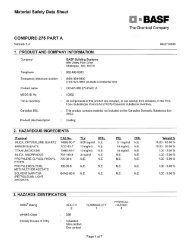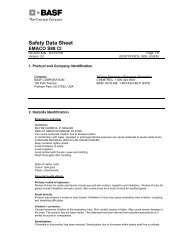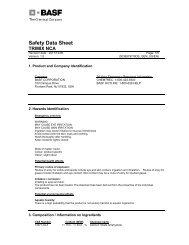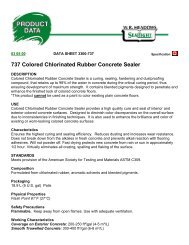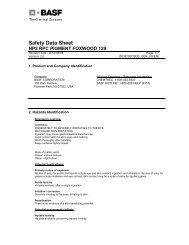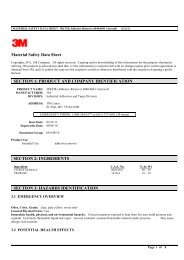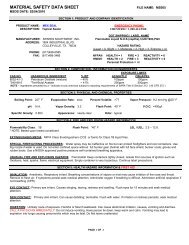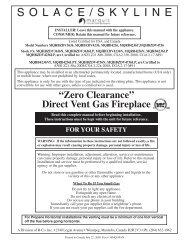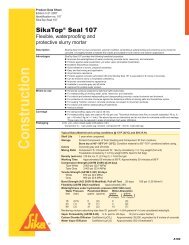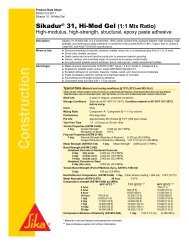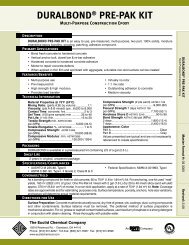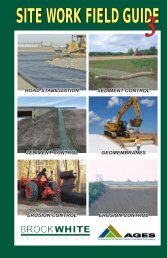Create successful ePaper yourself
Turn your PDF publications into a flip-book with our unique Google optimized e-Paper software.
Panel ErectionInformationPanel ErectionInformationresponsibility it is to clean the floor slab casting location assoon as the crane has lifted a panel and cleared the area.Regardless of how good a contractor’s housekeeping isprior to the lift, there is always a certain amount of debris leftbehind. This individual should also make certain that all leftoverforming nails are pulled from the slab.The rigging details furnished by Dayton Superior in theerection instructions are not merely simple guidelinesfrom which the erector can stray. THE RIGGING DETAILSDEFINE THE PROPER RIGGING FOR EACH PANEL FORTHE ERECTOR. Spreader bar widths and cable angles areintegral parts of the erection stress analysis.Proper cable lengths are important to the success of thelift.During the LiftPrecautionsWind conditions must be considered prior to lifting a panel.A 40-ton panel will easily move in a slight breeze whenhanging from a crane. All spectators should be kept wellaway from the lift and not allowed to interfere with the proceedings.Panels should be inspected prior to lifting for any reinforcingsteel and/or ledgers that may be projecting beyond thepanel edges that will create interference when the panelis being plumbed next to a previously erected panel. Thishappens most often at corners.After all attachments are made to the panel, and as therigging is being raised to take the slack out of the cables,but prior to initial loading of the inserts, all rigging gear mustbe inspected for proper alignment and be free of snags. Ifnon-swivel type sheaves are used, make certain the sheavesare properly aligned. As cables are being tensioned, theyPlumbing PanelsPrecautionsBe alert when plumbing panels to their final upright position.Caution must be taken to make certain the panel beingplumbed does not strike a previously erected panel. Allpersonnel should be cleared of those critical areas arounda panel when plumbing is being done. If the panel beingplumbed is a closure panel, measurements should be takenprior to lifting to make certain the panel will fit.Tilt-up panels should be as plumb as possible priorto attaching the brace to the floor attachment anchor.Temporary out-of-plumb-ness SHOULD NOT EXCEED 4”measured at the top of the panel. It is generally more practicalto “fine tune” the panel plumb-ness with the pipe bracesafter the lift is completed.BracingGeneralDo not release the crane load if, for any reason, the bracingdoes not appear adequate. Crane loads should always bereleased slowly, keeping an eye on the panel and bracing forany unusual activity. It is desirable that all bracing be completebefore releasing the crane. That is, all knee, lateral, andend or cross bracing, if required, be in place. However, this isnot always possible. You should always be able to install theknee bracing, however, the crane’s position near the panelThe use of cables that are shorter than the prescribedlength will increase stresses in the panel and could causethe panel to crack. If an erector has a problem with riggingdetails or cable lengths, as they are shown in the erectioninstructions, he should not take it upon himself to changethem. Instead, a call should be made to the technical servicecenter from which the erection instructions originated. Analternate solution may be worked out depending on the individualsituation.Extra precautions should be taken when lifting panels withspecial shapes or special rigging. The erection instructionsshould be consulted for CAUTIONARY NOTES as to how apanel might act during lifting, and to again verify the riggingand the insert locations.invariably tend to twist and possibly rotate the lifting hardwarecausing side loading on the hardware. The riggerforeman should be alert for this condition and if it doeshappen, SHOULD HALT THE LIFT AND REALIGN THEHARDWARE.It is the rigger foreman’s responsibility to be alert to allobstacles in the path of the crane and crew. He should bealert for panels that may be stuck to the casting surface.Under such conditions, loads transferred to the lifting insertscould be more than doubled causing possible insert failure.Carefully positioned, pry bars and wedges can often besuccessful in helping the crane release the panel from thecasting surface. Any wedges that are applied to help releasethe panel should be positioned at the insert lines.Braces are almost always attached to the panel prior tolifting. Caution must be taken to be certain the braces willnot be trapped by the rigging when the panel is in the uprightposition.There are two commonly occurring conditions that dictatethat the panels be braced perfectly plumb prior to releasingthe crane:1 ) If the panel is going to support an adjacent spandrel orlintel panel, the supporting panel should be in an accuratefinal position to prevent having to adjust it later when it issupporting another panel.2) If the bracing design calls for a subsupport systemof knee, lateral, and end or cross bracing, then the panelshould be accurately plumbed prior to attaching the subsupportsystem. Panels requiring subsupport systems must notbe plumbed later as the brace subsupport system, if notremoved, must be at least loosened in order to adjust themain brace, thus placing the panel in a dangerous position.may prevent the lateral bracing from being attached.Once the crane is clear of the area, the panel contractormust complete the lateral and end or cross bracing. He mustcomplete this phase of the bracing while remaining no morethan one panel behind the erection crew. All bracing shouldbe completed on all erected panels at the end of the workday.22 02-09



